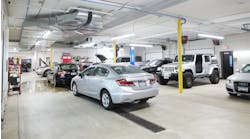Most of us understand that if you are not growing, you are probably slowly going out of business. With costs increasing every year and our people wanting to grow, there is pressure on all shop owners to continue to grow their business. I was listening to a long-time shop owner and now ATI coach, Kim Hickey, explain to her clients how to continue to grow their shop. And I thought you would enjoy her unique story.
When I decided to make the leap from being a passenger on a motorcycle to the "rider," I decided to take a motorcycle safety class. To be honest with you, I did not think I would learn anything. After all, I had been riding on the back of some form of motorcycle for at least 15 years, but there was an insurance discount involved. Having ridden on the back for so many years, I was quite accomplished at mentally deciding when the rider should have slowed down, sped up, braked sooner, braked later, shifted gears, etc. What I didn't understand is that when you are on the back, you are not the one responsible for everyone's safety. You don't have to be ready to swerve, stop, avoid getting hit, judge your speed around turns, maneuver through gravel and slick roads, dirt roads, hairpin turns, switchbacks, and many other things. You get to sit on the back and ooh and ah at what you see and point out things for the rider to look at. You can chat away without a second thought because YOU KNOW the person in front of you has got this. Your duties as a passenger are spelled out to you clearly by the rider. All you are responsible for is holding on during acceleration, leaning with the driver in turns, not making any sudden dramatic movements, and not unexpectedly screaming. Both the rider and the passenger on a bike each have their own responsibilities, which are spelled out.
Look Where You Are Going, Not Where You Are
In class, one of the first things they taught us was to look where you are going and not where you are. I'm one of those people that learns things by doing them. During class the directive of “look where you are going, not where you are” didn't make sense to me. How could you possibly not look where you are? My instructor then explained that the bike will go in the direction that you are looking, so if you are turning right, you need to look right and then the bike will follow. I was still convinced that what he said did not make any sense, so this was one of the first things I tested when I got my license and was on my own. To my surprise, he was right. Still today I chuckle when I start daydreaming a bit on my bike and look off to the right or left of the road for a second or two, and my bike instantly starts to drift in that direction.
When you ride in a group, there is typically a road captain. It is the road captain’s responsibility to determine the route you will be taking during your ride. The road captain will go out a day or so before the ride and ride the route themselves. As they are taking the route, they are looking for any potential problems or things that the group may need to know about or that possibly could affect them. On the day of the ride, when the group gathers, the road captain will have a brief meeting with the group. The captain will spell out to the group the exact route they will be taking, advise the group of any potential problems or things to watch out for, how long it will take them, when and where they will be stopping for breaks. The road captain is responsible for the safety of the group and keeping things on track and on pace.
Run Your Shop Like You Ride a Motorcycle
There are valuable business lessons to be learned from riding a motorcycle. I realized that when I was the most successful at running my shop, I ran my shop like I ride my motorcycle. In order to be successful as a rider, or a business owner, you need to look ahead to where you are going, and not get stuck looking where you are. Do you have a plan? Do you know where you want to end up? What is your timeframe for getting where you want to go? What are your six-month goals, your one-year goals, your 10-year goals? When do you want to retire? Is it your desire to build up the business to sell? Is it your dream to have multiple locations? Do you want to build your brand into one that could be franchised?
What are your contingencies if you hit a bump in the road? Do you have someone that is capable of carrying out your plan in your absence? Are you constantly working on your budget five years out so you know exactly where you will or should be from year to year, thus allowing you to plan ahead for hiring, marketing, and possible building expansion or additional locations? Have you opened a savings account and built up at least three to six months of your expenses in case of an emergency? Do you have a succession plan in place so your shop can continue to run if you are no longer able to run it? Do you explore new ideas?
Do you update your equipment and keep it in shape? Do you make sure that your staff knows what route you are taking for your business? Do they know where they are headed? Do you meet with them often and explain where you are headed and what potential problems you foresee arising going forward? Are you and your staff forward-thinking?
Are You a Rider or a Passenger?
Another thing riding has taught me is that some people are meant to be riders and some people are meant to be passengers. Just because you are a great motorcycle passenger with years of experience, doesn't mean you will be a great rider. Just because you are a great tech or service advisor with years of experience, doesn't mean you will make a great shop owner. Because your parents or grandparents owned a shop for 30 years and you have been around it since before you could walk, doesn't mean you will be a great owner. Merely owning a shop, doesn't guarantee that you will run it well. Just because you own a shop doesn’t mean you will be a great businessperson, or that you will be a great leader.
But many people can succeed as owners with the proper training. Shop owners that go through programs like ATI have a much higher success rate.
For both the motorcycle rider and the shop owner, tools and equipment are needed. Riders should have boots, gloves, long sleeves, long pants, helmet, leathers and goggles. Your shop and your employees should have an array of tools, diagnostic equipment, flush machines, access to technical information, etc. Hopefully part of both tool sets is continued education and training. Service advisors are equipped with sales and customer experience skills. In addition to your staff’s skill set and tools, hopefully you are fostering an environment where your staff is encouraged to look where they are going and not where they are.
Can Your Shop Run Without You?
Most importantly, riders and shop owners have to have a clear plan. All parties involved must know, without question, what their responsibilities are and what is expected of them. Processes must be put in place and best practices must be followed. Without best practices, how would we be able to consistently ensure the safety of everyone involved, provide a fantastic customer experience every single time, and maintain a seamless workflow? Another part of the shop owner’s responsibility is to make sure that the processes work and best practices are followed not only when the owner is there, but also if they are not. That absence could be for a day, a month, a year, or permanently. If you are one of those shop owners that say “The shop can’t run without me,” then you do not have the consistent processes in place that are needed.
Starting right now, I want you to remember to always look where you are going, not where you are. Don’t lose sight of or neglect your responsibilities as a shop owner. Know exactly where your shop is headed, and run your business like I ride my motorcycle.
For a checklist to help you decide where your shop is going and to assist you with How to Set and Achieve Goals, for a limited time simply go to www.ationlinetraining.com/2014-12.
Subscribe to Motor Age and receive articles like this every month…absolutely free. Click here


